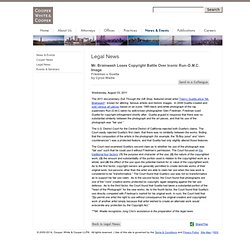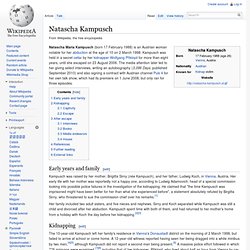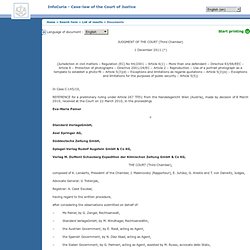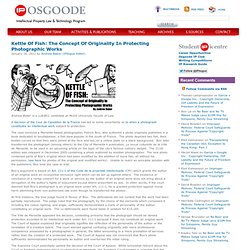

Photographers, copyright and the online battle for photo rights. Another Appropriation Artist Loses Copyright Lawsuit; Are We Nearing The End Of Appropriation Art? With Shepard Fairey settling his lawsuit with the AP over an appropriated photo of President Obama, and Richard Prince losing his lawsuit for appropriating a photograph and then adding some paint to it, it seems like appropriation artists are running into more and more legal troubles.

And now there's another such legal ruling. Thierry Guetta, who was made famous by being the centerpiece of Banksy's Exit from the Gift Shop documentary, has failed to persuade a judge that his artwork does not infringe on the photograph by Glen E. Friedman of the band Run DMC. All photos are created equal – the Painer case in the CJEU. The Court’s decision answers questions on the breadth of copyright protection for works based on reality such as portrait photos, and interprets the “criticism and review” and “public security” exceptions to copyright, as well as dealing with a narrow point on jurisdiction.

As discussed below, this Kat suspects that in Painer the Court also chose to answer a question it was not asked: just what did it mean by its earlier Infopaq decision - did it harmonise the level of creativity for all copyright works or not? Recall that the UK Court of Appeal held in NLA v Meltwater that Infopaq had no effect on the UK's traditional and minimal requirement of originality for copyright works. The background Briefly, the Painer case arose out of events surrounding the abduction in 1998 of Natascha Kampusch, a.k.a. Natascha K., then aged 10, and her escape in 2006. Are portrait photos accorded “narrow” protection? Calling London: here's what we really meant in Infopaq ... Painer: pain for the press? On 1 December the Court of Justice delivered its 150-paragraph ruling in Case C-145/10 Eva-Maria Painer v Standard VerlagsGmbH, Axel Springer AG, Süddeutsche Zeitung GmbH, SPIEGEL-Verlag Rudolf AUGSTEIN GmbH & Co KG and Verlag M.

DuMont Schauberg Expedition der Kölnischen Zeitung GmbH & Co KG (Opinion of AG Trstenjak noted by the IPKat back in April here). As our readers may remember, this case was a reference for a preliminary ruling from the Handelsgericht Wien (Austria), in the context of proceedings for copyright infringement brought about by photographer Eva-Marie Painer against some Austrian and German newspaper and magazine publishers. Ms Painer is a freelance photographer and took several photographs of Natascha Kampusch designing the background, deciding the position and facial expression, and producing and developing them. Ms Painer sold the photographs which she produced, but without conferring on third parties any rights over them and without consenting to their publication.
Mr. Brainwash Loses Copyright Battle Over Iconic Run–D.M.C. Image. Wednesday, August 03, 2011 The 2011 documentary Exit Through the Gift Shop, featured street artist Thierry Guetta a/k/a “Mr.

Brainwash”, known for altering famous artistic and historic images. In 2008 Guetta created and sold various art pieces based on an iconic 1985 black-and-white photograph of the rap superstars Run–D.M.C.taken by well-known photographer Glen Friedman. Friedman sued Guetta for copyright infringement shortly after. Guetta argued in response that there was no substantial similarity between the photograph and the art pieces, and that his use of the photograph was “fair use.”
The U.S. The Court next examined Guetta’s second claim as to whether his use of the photograph was “fair use” such that he could use it without Friedman’s permission. ***Mr. Natascha Kampusch. Natascha Maria Kampusch (born 17 February 1988) is an Austrian woman notable for her abduction at the age of 10 on 2 March 1998.

Kampusch was held in a secret cellar by her kidnapper Wolfgang Přiklopil for more than eight years, until she escaped on 23 August 2006. The media attention later led to her giving select interviews, writing an autobiography (3,096 Days, published September 2010) and also signing a contract with Austrian channel Puls 4 for her own talk show, which had its premiere on 1 June 2008, but only ran for three episodes. Early years and family[edit] Kampusch was raised by her mother, Brigitta Sirny (née Kampusch), and her father, Ludwig Koch, in Vienna, Austria.
Her early life with her mother was reportedly not a happy one, according to Ludwig Adamovich, head of a special commission looking into possible police failures in the investigation of the kidnapping. Her family included two adult sisters, and five nieces and nephews. Kidnapping[edit] Captivity[edit] Escape[edit] InfoCuria. Language of document :

Paris Court Rejects Photographer's Copyright Claim. Author: Eduard Marmet.

IP Osgoode » Kettle Of Fish: The Concept Of Originality In Protecting Photographic Works. Andrew Baker is a LLB/BCL candidate at McGill University Faculty of Law.

A decision of the Cour de Cassation de la France has led to some uncertainty as to when a photograph constitutes an intellectual work subject to protection. The case involved a Marseille-based photographer, Patrick Box, who authored a photo originally published in a book dedicated to bouillabaisse, a fish stew popular in the south of France. The photo depicted two fish, their bodies curved so that they were joined at the face and tail, on a yellow plate on a black background.
Box later transferred the photograph (among others) to the City of Marseille’s publication, La revue culturelle de la Ville de Marseille, to be used in an upcoming article on the topic of the city’s famous culinary delight. The 211th edition was released in December 2005 containing a photo authored by another photographer. At first instance, the trial judge found in favour of Box.
Lens Blog. Copyright in Photographs: Temple Island Collections and Creation Records. In our very first NIPC newsletter which we published in June 1997 I wrote a case note on Mr.

Justice Lloyd's decision in Creation Records Ltd. and Others v News Group Newspapers Ltd [1997] EMLR 444, [1997] EWHC Ch 370, (1997) 16 Tr LR 544. In that case Mr. Noel Gallagher of Oasis and others applied for an interlocutory injunction to restrain The Sun from offering for sale and selling a poster of Oasis that featured a photo of an elaborate set that included a white Rolls Royce in a country club swimming pool. The Sun's photograph was very similar to the photograph that appeared on an Oasis album cover. The similarity arose because The Sun's photographer shot the same scene at roughly the same time and from the same angle as Mr.
That design was intended to be very similar to, but not actually copy, a photograph of a very similar scene that had been made by the founder and Mr. "4. ................. "I do not regard this as seriously arguable. Conditions de protection d’une photographie par le droit d’auteur.